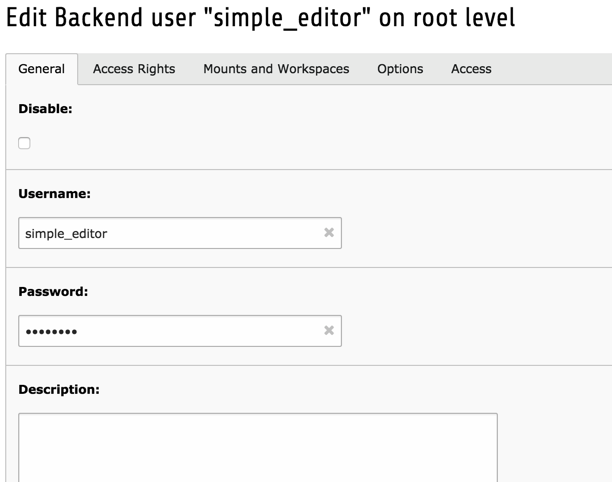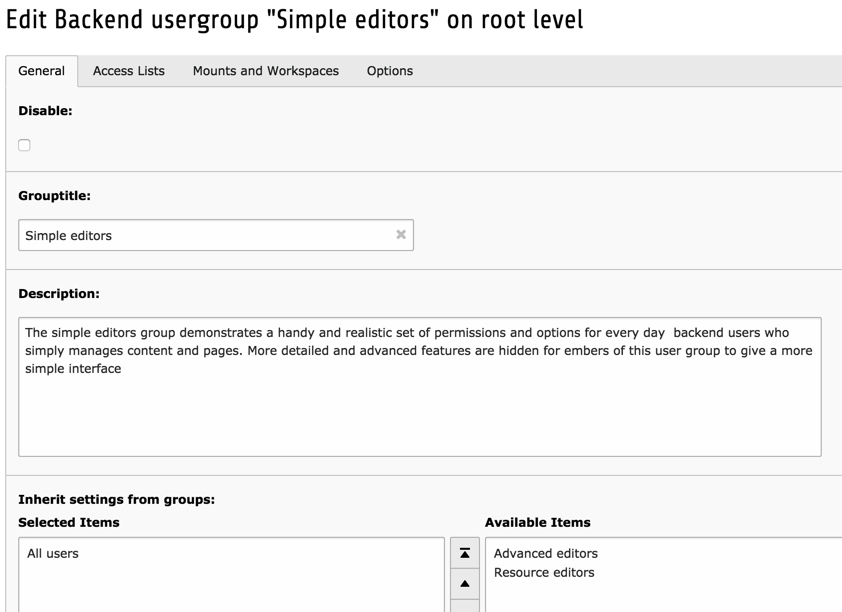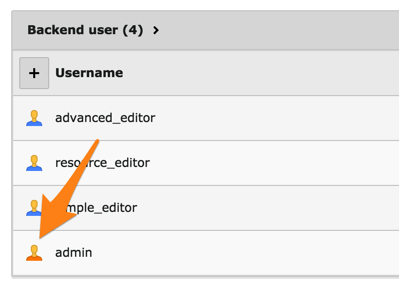Attention
TYPO3 v9 has reached its end-of-life September 30th, 2021 and is not maintained by the community anymore. Looking for a stable version? Use the version switch on the top left.
You can order Extended Long Term Support (ELTS) here: TYPO3 ELTS.
Users and Groups¶
TYPO3 CMS features an access control system based on users and groups.
Users¶
Each user of the backend must be represented with a single record in the table "be_users". This record contains the username and password, other meta data and some permissions settings.

The above screenshot shows a part of the editing form for the backend user "simple_editor" from the Introduction Package. If you have an Introduction Package available, you can check further properties of that user. It is part of the "Simple editors" group, has a name, an email address and its default language for the backend is English.
It is possible to assign rights directly to a user, but it is much better done using groups. Furthermore groups offer far more options.
Groups¶
Each user can also be a member of one or more groups (from the "be_groups" table) and each group can include sub-groups. Groups contain the main permission settings you can set for a user. Many users can be a member of the same group and thus share permissions.
When a user is a member of many groups (including sub-groups) then the permission settings are added together so that the more groups a user is a member of, the more access is granted to him.

This screenshot shows just an extract of the group editing form. It contains many more fields!
The "admin" User¶
There is a special kind of backend users called "Admin". When creating a backend user, just check the "Admin!" box in the "General" tab and that user will become an administrator. There's no need to set further access options for such a user: an admin user can access every single feature of the TYPO3 CMS backend, like the "root" user on a UNIX system.
All systems must have at least one "admin" user and most systems should have only "admin" users for the developers - not for any editor. Make sure to not share TYPO3 accounts with multiple users but create dedicated accounts for everyone. Not even "super users" should be allowed "admin" access since that will most likely grant them access to more than they need.
Admin users are differentiated with an orange icon.

Note
There's no other level between admin and ordinary users. This seems to be a strong limitation, especially when you consider that ordinary users may not access TypoScript templates.
However, there is a security reason for this. From a TypoScript template, you can call a PHP script. So - in effect - a user with access to TypoScript can run arbitrary PHP code on the server, for example in order to create an admin account for himself. This type of escalation cannot be allowed.
Location of Users and Groups¶
Since both backend users and backend groups are represented by records in the database, they are edited just as any other record in the system. However backend users and groups are configured to exist only in the root of the page tree where only admin users have access:

Records located in the page tree root are identified by having their "pid" fields set to zero. The "pid" field normally contains the relation to the page where a record belongs. Since no pages can have the id of zero, this is the id of the root. Notice that only "admin" users can edit records in the page root!
If you need non-admin users to create new backend users, have a look
at the TYPO3 system extension sys_action for a possible solution.
